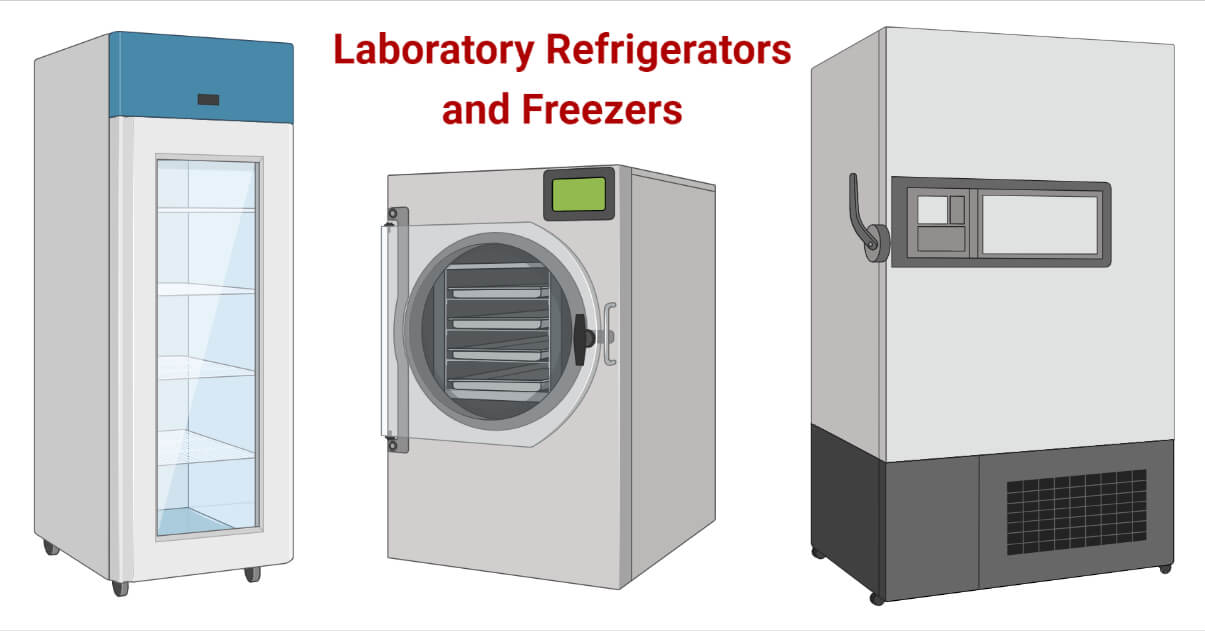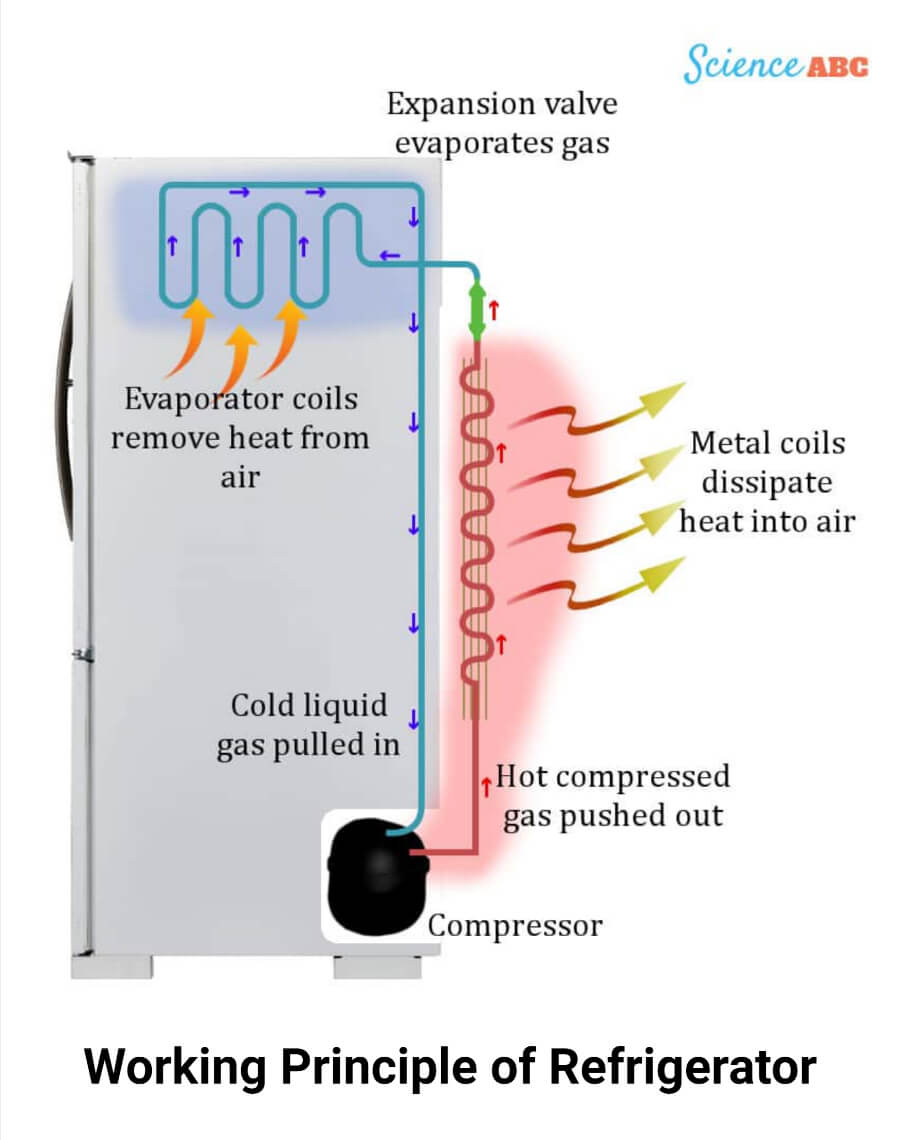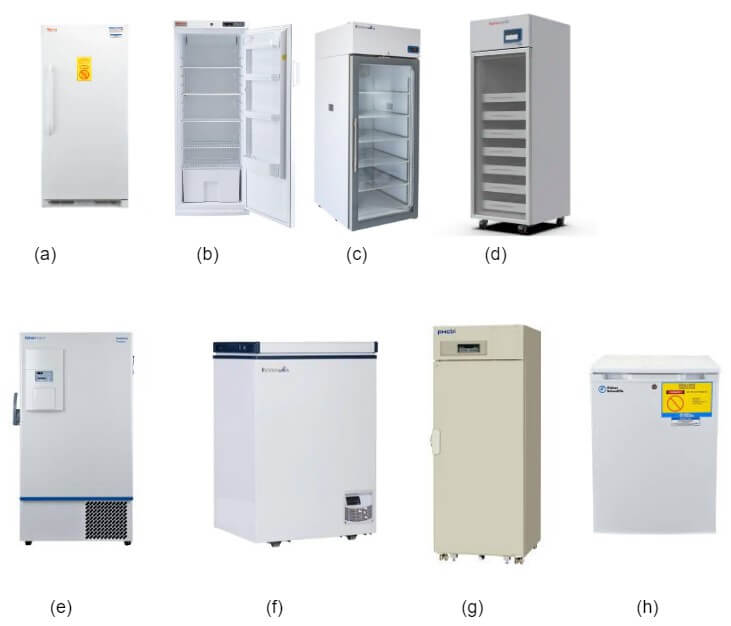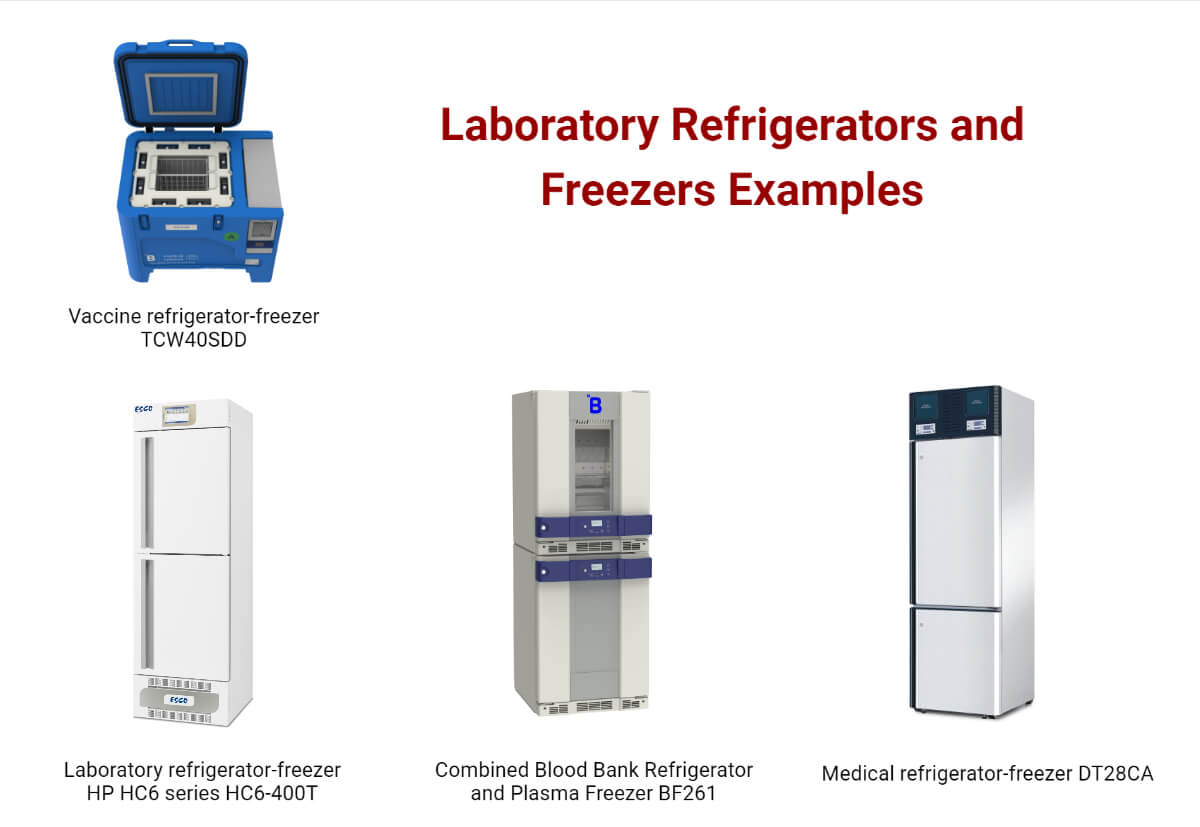A refrigerator, also known as a “fridge,” is an appliance made up of a thermally insulated compartment and a mechanical, electronic, or chemical heat pump that transfers heat from the interior to the exterior to cool the interior down below room temperature.
Laboratory refrigerators are distinct from regular refrigerators used in homes and restaurants because they must be 100 percent hygienic and 100 percent dependable.
The fridge in the lab is the same as the one in our house. Its use and calibration needs are what differentiate it. Samples and specimens are cooled in laboratories so they can be preserved. They comprise refrigeration units for holding vaccines and other pharmaceutical or medical supplies, as well as blood plasma and other blood products.

To reduce the risk of bacterial contamination and volatile material explosions, laboratory refrigerators must maintain a constant temperature. The refrigerator requires air circulation and a fan to maintain a consistent temperature to operate with high levels of accuracy. To stop cold air from blowing outside the unit when the door is open, the fan shuts off. Laboratory refrigerators have distinct sections to prevent contamination.
Below the freezing point, a substance’s state changes from liquid to solid, a phenomenon known as freezing. Laboratory freezers are cold cabinets that can keep biological samples and flammable chemicals at temperatures between -80ºC and 10ºC. Laboratories, hospitals, blood banks, production facilities, material testing labs, and diagnostic centers all employ laboratory freezers.
The usual temperature range for storing samples in refrigerators is between – 5ºC and – 15ºC, whereas the usual range for storing samples in freezers is between -25ºC and -15ºC. The only difference in temperature is what distinguishes refrigerators from freezers. Some lab freezers and refrigerators are also utilized as incubators that alternate between heating and cooling cycles. These refrigerators are frequently employed for culturing and monitoring the development of microorganisms.
Interesting Science Videos
Working Principle of Laboratory Refrigerators and Freezers
An appliance like a refrigerator uses mechanical work to move heat from one area with a lower temperature to another with a higher temperature. The term “refrigeration cycle” or “vapor-compression refrigeration cycle” refers to this regular heat transfer.
The refrigerant gas is first compressed, raising its temperature and pressure. In the meantime, heat exchange coils on the refrigerator’s outside aid in dissipating the heat produced by the pressure.
The refrigerant liquefies into liquid form when it cools, at which point it passes through the safety valve. The liquid refrigerant moves from the high-pressure region to the low-pressure region when it goes through the safety valve, where it expands and evaporates. It absorbs heat during the evaporation process and has a cooling effect.
Coils assist the refrigerant within the refrigerator to absorb heat and maintain a chilly interior. Repeat the loop step one more
When a substance transforms from a liquid to a solid, heat is transferred from the body to the environment. The kinetic energy of liquid particles reduces due to heat evolution, and they move more slowly. After some time, a point is reached when the mobility of the particles is so minimal that they are drawn together by attractive forces and turn into solids during freezing.

Components of Laboratory Refrigerators and Freezers
Several components of the refrigerator/freezer are discussed below:
Refrigerant: A refrigerator’s refrigerant is its essential component. As it moves through the components of the refrigerator, it changes from a gas to a liquid and back to a gas. The refrigerator is cooled using this approach. Examples include freon and ammonia. The HFC 134a gas is now used by the majority of contemporary refrigerators.
Compressor: The compressor is a refrigerator’s “heart.” where the cooling process begins. The refrigerant gas is sent to the condenser at a higher temperature and pressure thanks to the compressor, which is powered by a motor. It forces pressure on the warm portion of the circuit and circulates the refrigerant throughout the system.
Condenser: On the back of a refrigerator, the condenser is probably pretty dusty. The refrigerant cools down within and condenses the transferred hot vapors, changing from a gas to a liquid. It can be identified by the substantial copper coils.
Capillary Tube (Expansion Valve): An expansion device, the capillary tube is a tiny set of copper tubes. The expansion valve drastically reduces the temperature and pressure of the liquid refrigerant, which results in the evaporation of nearly half of it. This facilitates the cool conditions inside the freezer and/or refrigerator.
Evaporator: The component of a refrigerator that keeps the contents chilled is called an evaporator. It begins the process of the next cycle. It uses the remaining refrigerant liquid to create vapor again, which the compressor uses to restart the process creating the ideal atmosphere for preserving food.
Accessories
Thermistor: It monitors the internal temperature of the refrigerator.
Evaporator Fan Motor: The fan that distributes cold air across the freezer and refrigerator compartments is driven by an evaporator fan motor.
Condenser Fan Motor: Fans are used to drive air through condenser coils in refrigerators with compressor compartment mountings to cool the refrigerator and dissipate heat.
Water Inlet Valve: It is responsible for generating enough water pressure to open the valve and dispense water into the ice tray to make ice.
Water Filter: A clogged water filter prevents water from reaching the ice maker, preventing ice formation.
Thermometers and alarms are fitted.
Types of Laboratory Refrigerators and Freezers
Different types of refrigerators and freezers are briefly described below:

Refrigerator Types
Explosion-proof refrigerators: Flammable liquids and dangerous chemicals can be stored in explosion-proof refrigerators. It is safe to use with flammable materials because there are no electrical appliances in the storage space, which avoids fire by sparks. This kind of refrigerator is required in solvent dispensing rooms where a combustible environment may occasionally arise.
Lab fridges: Lab refrigerators are made to keep temperatures stable and to display temperature information digitally. Since they are standard laboratory refrigerators, they must have parts that are lockable and easy to clean. Additionally, they are utilized for preservation and cooling samples.
Blood bank refrigerators: A constant temperature is maintained in blood bank refrigerators to store and safeguard chilled whole blood, blood components, and blood products.
Chromatography refrigerators: These are designed for scientific experimentation. They work best in laboratories where precise temperature controls and stability are needed for medical samples and procedures. For instance, a chromatography setup might be made inside the refrigerator chamber of a lab refrigerator.
Freezer Types
Ultra-low temperature Freezers: Ultra-low temperature freezers are perfect for storing items that require very low temperatures In laboratories and healthcare facilities. It enables storage of such goods at below -40°C temperatures. Some ultra-low freezers may achieve temperatures as low as -86°C because they have two independent evaporator circuits surrounding the interior chamber.
Chest Freezers: Chest freezers are the greatest choice for labs that need to keep huge goods in a single unit because they are efficient. Chest freezers have alarm systems that warn the user of lock changes, temperature changes, and digital temperature readings. Shelves are not present in chest freezers.
Under-Counter Freezers: Under-counter freezers come in a variety of configurations, including all-purpose, explosion-proof, and the option for explosive material storage. Under-counter freezers have forced air ventilation, so extra clearing space is unnecessary for the general-purpose type. There is also a setting for limiting the frequency of defrosts, which prevents any unexpected thaws or dehydration of the samples.
Upright Freezers: The interior of upright freezers is equipped with shelving units, allowing the efficient organization of samples and making the most of the available space. Because of their vertical shape, upright freezers don’t take up much space on the floor while holding most supplies. It promotes temperature homogeneity to ensure that all lab samples are exposed to the same circumstances.
Laboratory Refrigerators and Freezers Operating procedures
- Never keep flammables in a household (domestic) refrigerator with a flash point lower than 37.8°C (100°F).
- Never keep food or beverages intended for human consumption in a freezer or refrigerator used in a lab.
- Verify the compatibility of the substances kept in the refrigerator.
- All containers in a refrigerator or freezer should be securely positioned and thoroughly sealed. Aluminium foil, corks, and uncoated glass stoppers should not be used to close containers.
- Plastic trays that are appropriate for secondary containment in the refrigerator and freezer compartments should be present on all refrigerator shelves.
- All materials stored in a refrigerator must be properly labeled. If plastic trays are unavailable, liquid chemicals should be put in secondary containers to limit the spill.
- Keep only the chemicals you will need for a reasonable time in storage. If not properly maintained and sealed, substances kept in refrigerators could be particularly susceptible to degradation.
- At least once a year, or as frequently as necessary, refrigerators and freezers should be cleaned out and manually defrosted.
Applications of Laboratory Refrigerators and Freezers
- Refrigerators facilitate the storage of samples and specimens, as well as vaccines and medicines, at a specific temperature to ensure they do not become spoiled, while freezers accurately freeze items rather than cool them.
- It maintains the stability of reagents needed in the chemistry analysis by facilitating a precise temperature control system during refrigeration.
- Anti-frost fans in laboratory refrigeration units keep moisture down, therefore, allowing a drier climate for dried reagents or materials that are susceptible to moisture contamination.
- It has provisions for climate control that maintain the quality of the microbiological media.
Advantages of Laboratory Refrigerators and Freezers
- A reliable cold chain is guaranteed by the use of freezers which is required to ensure the complete protection of biological materials such as blood transfusions, vaccinations, and other treatments.
- It facilitates the provision of correct temperature monitoring and alarm, which prevents temperature swinging, ensuring the safety of biological materials and vaccines.
- It promotes better airflow (ventilation) through powerful air circulation systems with air cooling vents in refrigerators and freezers.
- Some refrigerators and freezers built on purpose are set with digital locks, which limit access to only authorized personnel.
- Backup battery sources employed in the machine offer additional benefits during temperature excursions from power outages.
- It prevents or stops biological contamination in laboratories.
Limitations of Laboratory Refrigerators and Freezers
- Laboratory refrigerators and freezers could bring risks such as spillage, the emission of gases from the contents, and the potential presence of incompatible chemicals.
- It is costlier to run and repair and requires higher energy.
- If not disposed of appropriately, they are hazardous to the environment due to the refrigerant, such as CFCs which cause ozone layer depletion.
Precautions
- No sample or reference material ought to be left out in the open; instead, they ought to be contained in plastic bags or standard vials to avoid cross-contamination from being caused by samples being close to one another.
- Avoid the temptation just to put the sample somewhere because it won’t accomplish what is needed.
- Chemicals, standards, foods, and medications should be stored in temperature zones that are appropriate for their storage needs.
- Light-sensitive samples must be stored in opaque bags or vials that are amber in color.
- Labels should be properly attached and coated with a transparent film to prevent moisture condensation from making them unreadable.
- Only clean the cabinets and shelves after turning off the electricity, at least once a week.
Examples of Laboratory Refrigerators and Freezers
Vaccine refrigerator-freezer TCW40SDD (B Medical Systems)
- Based on the model, tropical operating temperatures range from 32 to 43 degrees Celsius.
- Web-based external temperature visualization and display in real-time.
- They are dangerous to the environment if improper disposal practices are not followed.
Medical refrigerator-freezer DT28CA (smeg)
- The automatic defrosting system with forced air ventilation for positive temperatures for the evaporator, while for negative temperatures, manual defrosting should be done.
- Safety door locks with a key dual LCD and double microprocessor electronic control.

Laboratory refrigerator-freezer HP HC6 series (ESCO)
- Intelligent Automatic Defrost detects ice buildup and only defrosts when necessary to maintain optimal performance in the units.
- Low power usage and LED lights save energy.
Blood bank refrigerator-freezer BF261 (B Medical Systems)
- The refrigerator compartment’s safety thermostat keeps the temperature from dropping below freezing.
- Audio-visual alarm system with remote SMS or email transmission.
- Rapid temperature recovery even when doors are opened often.
References
- https://www.newfane.wnyric.org/cms/lib/NY01001283/Centricity/Domain/95/How%20a%20Refrigerator%20Works.pdf
- https://www.tampaapplianceparts.com/blog/what-are-the-main-working-parts-of-a-refrigerator/
- https://byjus.com/question-answer/what-is-the-principle-of-freezing/
- https://www.danfoss.com/en/about-danfoss/our-businesses/cooling/the-fridge-how-it-works/
- https://medium.com/@ramilabworld/how-laboratory-refrigerators-and-freezers-are-used-in-the-lab-59ac561f8205
- https://lab-training.com/how-a-laboratory-refrigerator-is-different-from-a-household-refrigerator/
- https://americanbiotechsupply.com/blogs/american-biotech-supply/2020/10/08/types-of-lab-freezers-qualities-and-recommended-use
- https://www.globalspec.com/learnmore/labware_scientific_instruments/thermal_processing/laboratory_freezers_refrigerators
- https://ehs.oregonstate.edu/sites/ehs.oregonstate.edu/files/pdf/si/labrefrigerators_si.pdf
- https://www.directindustry.com/prod/b-medical-systems/product-241879-2438340.html
- https://www.directindustry.com/prod/smeg/product-105399-1844209.html
- https://www.directindustry.com/prod/b-medical-systems/product-241879-2438740.html
- https://www.directindustry.com/prod/esco/product-222439-2450402.html

Request for a price quote
We are Al-MASMAK establishment,
one of aggressive and famous in devices and equipment medical in Saudi Arabia.
I am interested get your price and work together with the following items :
1 – Digital thermostat for ICE maker, ACM 85, ASE0200, serial AD 029699 99 Number:-10
2-INNER RUBBER GASKET, AROUND THE SHELVES OF FREEZER COMPARTMENT FOR SANYO Ultra-Low Temperature FREEZER Model: MDF-U71V. Number:-5
3-?INNER PLASTIC FRAME OF FREEZER SHELVES FOR SANYO Ultra-Low Temperature FREEZER Model: MDF-U71V. Number:-10
4:-PUMP for medical fridge Model: OM1102UN-11 120V, 60HZ, 8W, IP54, TMAX: 35c, S3: 33% Non-submersible pump Number:-5
5:-3HP Bitzer Compressor, with Control Panel, Freon 410, -5° C to +5°C. Number:-1
6-5HP Bitzer Compressor with Control Panel, , Freon 410,-25°C to 8°C. Number:-1
7- Temperature sensor probe 0 to 8 degree Number:-15
Best price.
Waiting for your soon reply
We always strive to keep the industry up-to-date with the latest information. Thank you so much for your support!
https://www.allrefrigerants.com/refrigerants